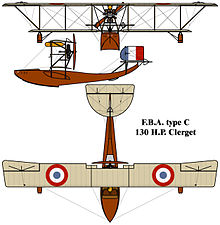User:NiD.29/FBA Type C
| F.B.A. Type B & Type C | |
|---|---|

| |
| Role | reconnaissance |
| National origin | France |
| Manufacturer | Franco-British Aviation (F.B.A.) |
| Built by | Norman Thompson, Gosport Aviation, SIAI and Lebedev |
| First flight | 1914 |
| Introduction | January 1915[1] |
| Status | retired |
| Primary users | Aéronautique Maritime Royal Naval Air Service Imperial Russian Navy |
| Produced | 1915-? |
| Number built | 594+ (Type B & Type C) |
| Developed from | FBA Type A |
| Variants | FBA Type S |
The FBA Type B (or 100hp) and the similar Type C (or 130hp) were French World War I single-engine pusher biplane reconnaissance flying boats used for anti-submarine patrols.
Development
[edit]The Type B and C had two bay wings and otherwise only differed from each other in the type of rotary engine installed, with the type B using a 100 hp (75 kW) Gnome Monosoupape and the type C using either a 110 hp (82 kW) Clerget 9Z or 130 hp (97 kW) Clerget 9B. Both versions had a pusher engine mounted with the propeller behind the wings, and the engine supported by numerous steel struts. They were developed from the much smaller FBA Type A, which had a single bay wing and a prominent fin ahead of the rudder, which the type B and C lacked.
These were unequal-span biplane flying boats with a single step hull built around ash longerons skinned in laminated wood and divided by bulkheads into eight compartments. The empennage was carried on an upswept curved extension of the hull and braced with steel tubing. The pilot and observer sat side by side in the open cockpit.[2]
Operational history
[edit]Variants
[edit]
- Type B
- powered by a 100 hp (75 kW) Gnome Monosoupape. Over 150 built.
- Type C
- (1915) powered by a 110 hp (82 kW) Clerget 9Z or 130 hp (97 kW) Clerget 9B.[1]
- Modified Type C
- powered by two Clerget 9B engines.
- Type 11 HE.2
- two-seat elementary training flying-boat based on the Type C.
- Type 14 HE.2
- two-seat training flying-boat based on the Type C, for the French Navy. 20 built.
- FBA 100ch
- French Navy nomenclature for the Type B with Gnome Monosoupape
- FBA 110ch
- French Navy nomenclature for the Type C with Clerget 9Z
- FBA 130ch
- French Navy nomenclature for the Type C with Clerget 9B
Operators
[edit]- Brazilian Naval Aviation - Two ex-RNAS Type B aircraft.
- Aéronautique Maritime - Operated approximately 300 examples of all types from 1915 to 1922.[1]
- Italian Naval Air Service - had 38 Type C in service in 1916
- Portuguese Naval Aviation - Three Type B aircraft.
- Imperial Russian Air Service
- Imperial Russian Navy - 64 Type B (30 from FBA and 34 from Lebedev), and 64 Type C (30 from FBA and 34 from Lebedev).
- Royal Air Force - 24 ex-RNAS aircraft still in service as of January 1919.
- Royal Flying Corps - some received for training.
- Royal Naval Air Service - 128 Type B trainers. 44 were from FBA, 4 were transferred from Italy. 80 were built in the UK, 20 by Norman Thompson and 60 by Gosport Aviation.
Survivors
[edit]A single example of a type B survives and is on display in the Museu de Marinha in Lisbon. This aircraft was reassembled from parts from the Portuguese Navy's first two aircraft.
Specifications (Franco-British Aviation Type C)
[edit]
Data from French Aircraft of the First World War[3]
General characteristics
- Crew: Two
- Length: 9.14 m (30 ft 0 in)
- Upper wingspan: 13.71 m (45 ft 0 in)
- Lower wingspan: 10.3 m (33 ft 10 in) [4]
- Height: 3.05 m (10 ft 0 in)
- Wing area: 32 m2 (340 sq ft)
- Empty weight: 640 kg (1,411 lb)
- Gross weight: 907 kg (2,000 lb)
- Powerplant: 1 × Clerget 9B 9-cylinder air cooled rotary engine, 97 kW (130 hp)
- Propellers: 2-bladed Levasseur 524 wooden fixed pitch propeller, 2.62 m (8 ft 7 in) diameter [5][note 1]
Performance
- Maximum speed: 110 km/h (68 mph, 59 kn)
- Range: 320 km (200 mi, 170 nmi)
- Endurance: 2.75 hours
- Time to altitude: 25 minutes to 2,000 m (6,600 ft)
Armament
- Guns: 1 x 7.7 mm (0.303 in) machine gun
- Bombs: 2 x 52 kg (115 lb) bombs[1]
See also
[edit]Related development
Aircraft of comparable role, configuration, and era
References
[edit]Notes
[edit]- ^ The Type B with 100hp Gnome used a 2.60 m (8 ft 6 in) Chauvière 2319
Citations
[edit]Bibliography
[edit]- Davilla, Dr. James J.; Soltan, Arthur (1997). French Aircraft of the First World War. Mountain View, CA: Flying Machines Press. ISBN 978-1891268090.
- Durkota, Alan; Darcey, Thomas; Kulikov, Victor (1995). The Imperial Russian Air Service — Famous Pilots and Aircraft of World War I. Mountain View, CA: Flying Machines Press. ISBN 0-9637110-2-4.
- Hartmann, Gérard (6 January 2015). "Les héliciers français" (pdf) (in French). Retrieved 5 August 2019.
- Morareau, Lucien (2002). Les Aeronefs de l'Aviation Maritime. Paris, France: ARDHAN (Association pour la Recherche de Documentation sur l'Histoire de l'Aeronautique Navale. pp. 44–47. ISBN 2-913344-04-6.
- Spooner, Stanley, ed. (27 December 1913). "The Franco-British Aviation Co Ltd". Flight. Vol. V (No. 52), no. 261. p. 1405. Retrieved 10 December 2018.
- Thetford, Owen (1982). British Naval Aircraft since 1912 (5 ed.). Putnam. p. 461. ISBN 0-370300211.
- Treadwell, Terry C. (2011). British & Allied Aircraft Manufacturers of the First World War. Gloucestershire, UK: Amberley Publishing. ISBN 978-1445601014.
